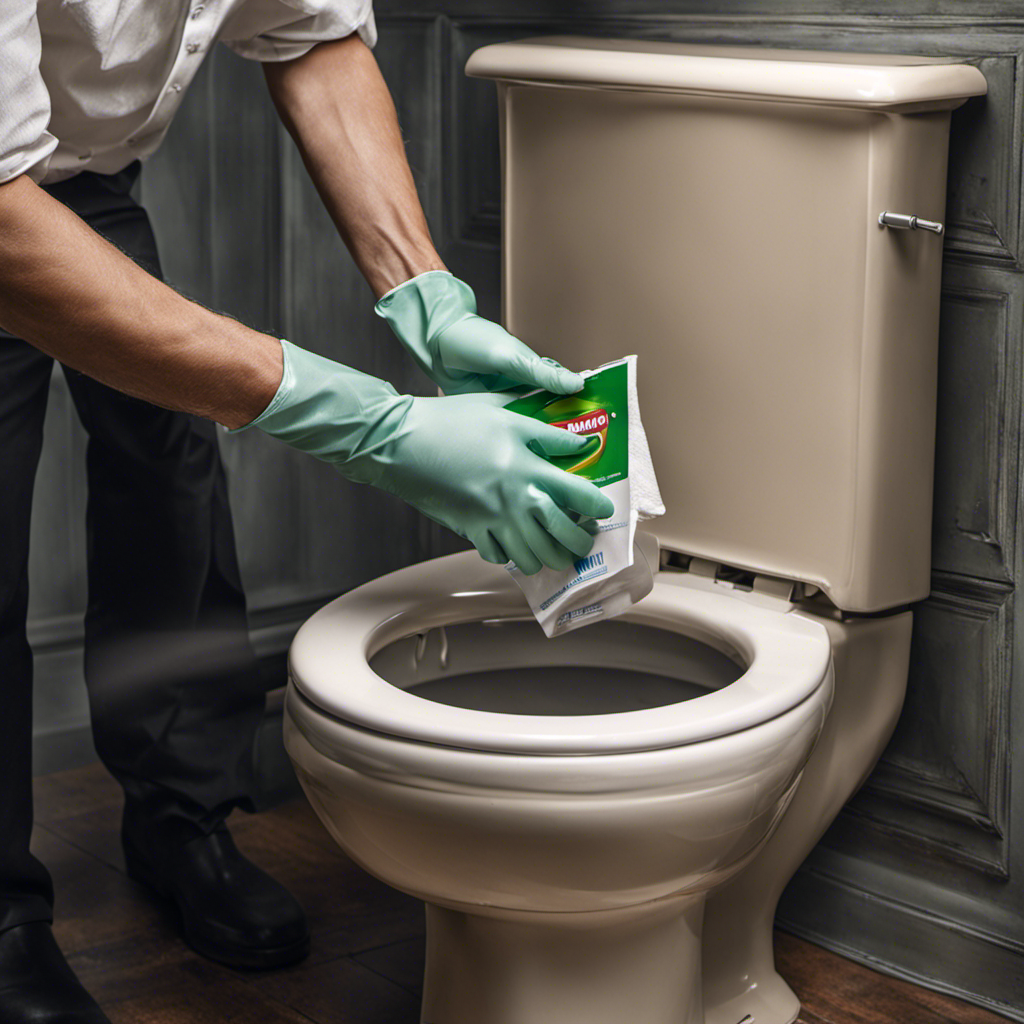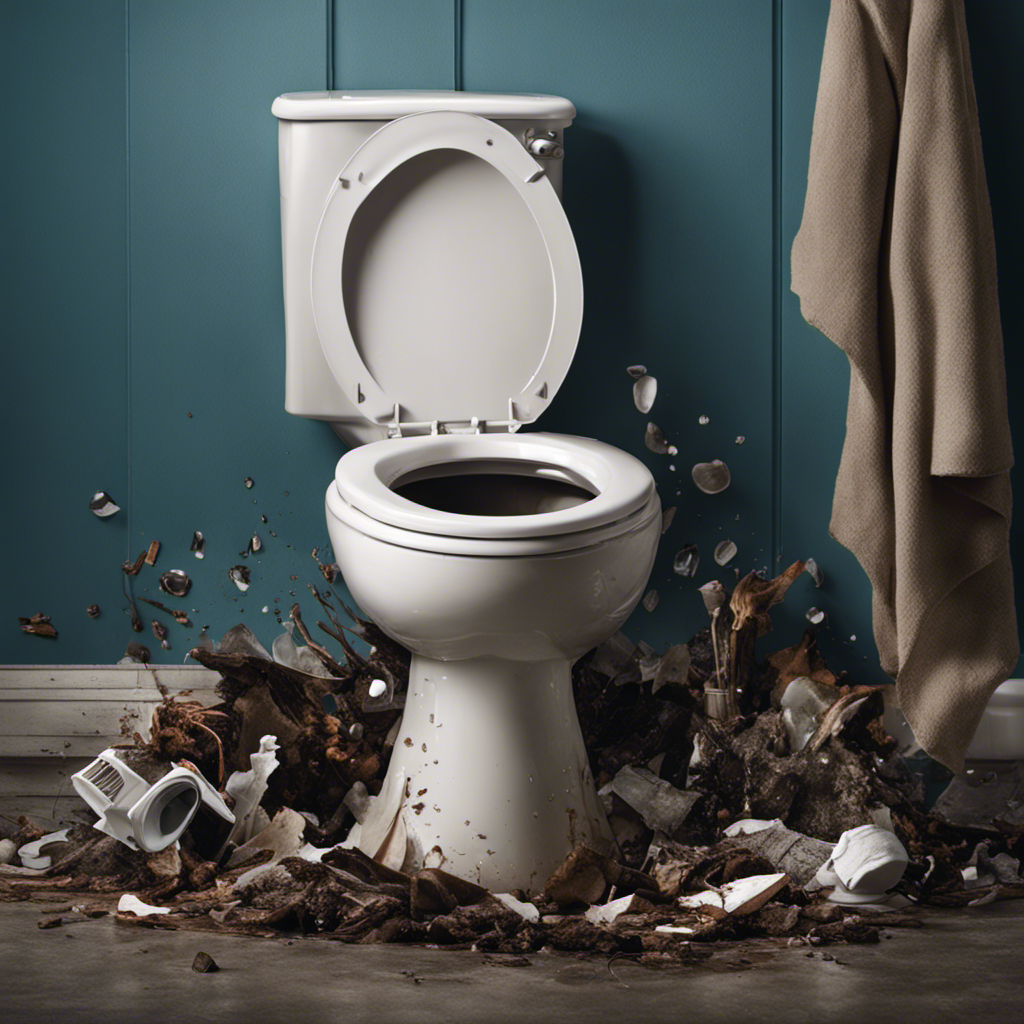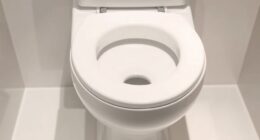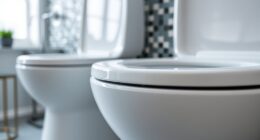Ladies and gentlemen, we’ve all encountered that fearful time during a blackout when the call of nature comes and the toilet refuses to flush.
Fear not, for we are here to guide you through the possibilities. From manually filling and flushing with water to utilizing rainwater, we will explore various options for a power-free flush.
With our precise and informative techniques, you’ll never have to worry about a powerless toilet again. So let’s dive in and discover the solutions that await us!
Key Takeaways
- Gravity flush systems and manual filling and flushing methods allow toilets to be flushed without power.
- Alternative options such as non-electric bidet attachments, composting toilets, portable camping toilets, and chemical toilets can also be used during power outages.
- Water conservation techniques, such as collecting and utilizing rainwater for flushing, are important during power outages.
- Maintaining proper hygiene without power can be achieved through the use of wet wipes or biodegradable toilet paper alternatives, hand sanitizer or disposable gloves for hand hygiene, and proper waste disposal and burial at a safe distance from water sources.
Gravity Flush Systems
With a gravity flush system, we can still flush the toilet even during a power outage. This type of system relies on the force of gravity and doesn’t require any electrical power.

When we press the flush lever, the water in the tank flows into the toilet bowl, creating a siphon action. This siphon action, combined with the water pressure in the pipes, effectively removes waste from the bowl and flushes it away.
The gravity flush system is simple yet efficient, making it a reliable option for flushing toilets without power. However, it’s important to note that without water pressure, the siphon action may be weakened, affecting the flushing performance.
In the event of a power outage, we may need to fill and flush the toilet manually, which we’ll discuss in the next section.
Fill and Flush With Water Manually
To manually fill and flush the toilet without power, we rely on our resourcefulness and adaptability. In times of emergency and power outage, it’s crucial to have water saving techniques and be prepared for such situations.

Here are three steps to fill and flush the toilet manually:
- Fill the tank: Use a container or bucket to collect water from a nearby source, such as a bathtub or rain barrel. Carefully pour the water into the tank until it reaches the recommended level, usually indicated by a water line inside the tank.
- Flush the toilet: Gently push down the toilet handle or lift the flapper to release the water from the tank into the bowl. This will initiate the flushing process.
- Repeat if necessary: If the flush isn’t strong enough, repeat the process by refilling the tank and flushing again.
Use a Bucket or Large Container
When faced with a power outage, using a bucket or large container can be an effective alternative for flushing the toilet. This method allows for manual flushing by pouring water directly into the bowl.
It’s important to consider water conservation during an outage, as resources may be limited, and to maintain proper hygiene practices without power.
Alternative Flushing Methods
We can use a bucket or large container as an alternative flushing method for toilets without power. This method is useful in situations where water supply is limited or during power outages. Here are three water-saving techniques for emergency sanitation:

- Fill a bucket or large container with water from an alternative source such as rainwater or a nearby pond. Use this water to manually flush the toilet by pouring it directly into the bowl. Be careful not to overflow the bowl.
- Another option is to use a dual-flush conversion kit. This kit allows you to control the amount of water used for each flush, reducing water consumption during emergencies.
- Consider using composting toilets as an alternative to traditional flush toilets. Composting toilets use little to no water and convert waste into compost, making them an eco-friendly and sustainable option.
Transitioning into the subsequent section about water conservation during an outage, it’s important to explore additional strategies to conserve water and minimize waste.
Water Conservation During Outage
During an outage, one option for conserving water is to utilize a bucket or large container for flushing toilets without power. This water-saving tip is crucial for emergency preparedness.
When faced with a power outage, it’s important to conserve water as much as possible, especially when it comes to flushing toilets. By using a bucket or large container, you can manually flush the toilet without relying on the power supply. Simply fill the container with water from another source, such as a nearby stream or rainwater collection system, and pour it into the toilet bowl.
This method allows you to maintain proper hygiene without wasting precious water. Remember to use only the necessary amount of water, as every drop counts during an outage.

Hygiene Considerations Without Power
To maintain proper hygiene without power, we can utilize a bucket or large container for flushing toilets. Here are three waterless hygiene solutions to consider during a power outage:
- Use dry toilet paper alternatives: When traditional flushing isn’t an option, it’s important to have alternative options for cleaning ourselves. Stock up on wet wipes, baby wipes, or even biodegradable toilet paper alternatives like bamboo or corn husk-based products.
- Practice hand hygiene with limited resources: Without running water, it can be challenging to maintain proper hand hygiene. Consider using hand sanitizer that contains at least 60% alcohol to effectively kill germs. Alternatively, keep a supply of disposable gloves to use during the power outage.
- Dispose of waste properly: In the absence of a functioning toilet, it’s essential to dispose of waste properly to prevent the spread of disease. Seal waste in plastic bags and dispose of them in designated waste collection areas or bury them at a safe distance from water sources.
Utilize Rainwater for Flushing
When it comes to flushing the toilet without power, one eco-friendly and efficient solution is to utilize rainwater.
Rainwater can be collected and stored in barrels or tanks, providing an alternative source for flushing when the plumbing isn’t functioning.
This method not only conserves water but also reduces the reliance on traditional plumbing systems.
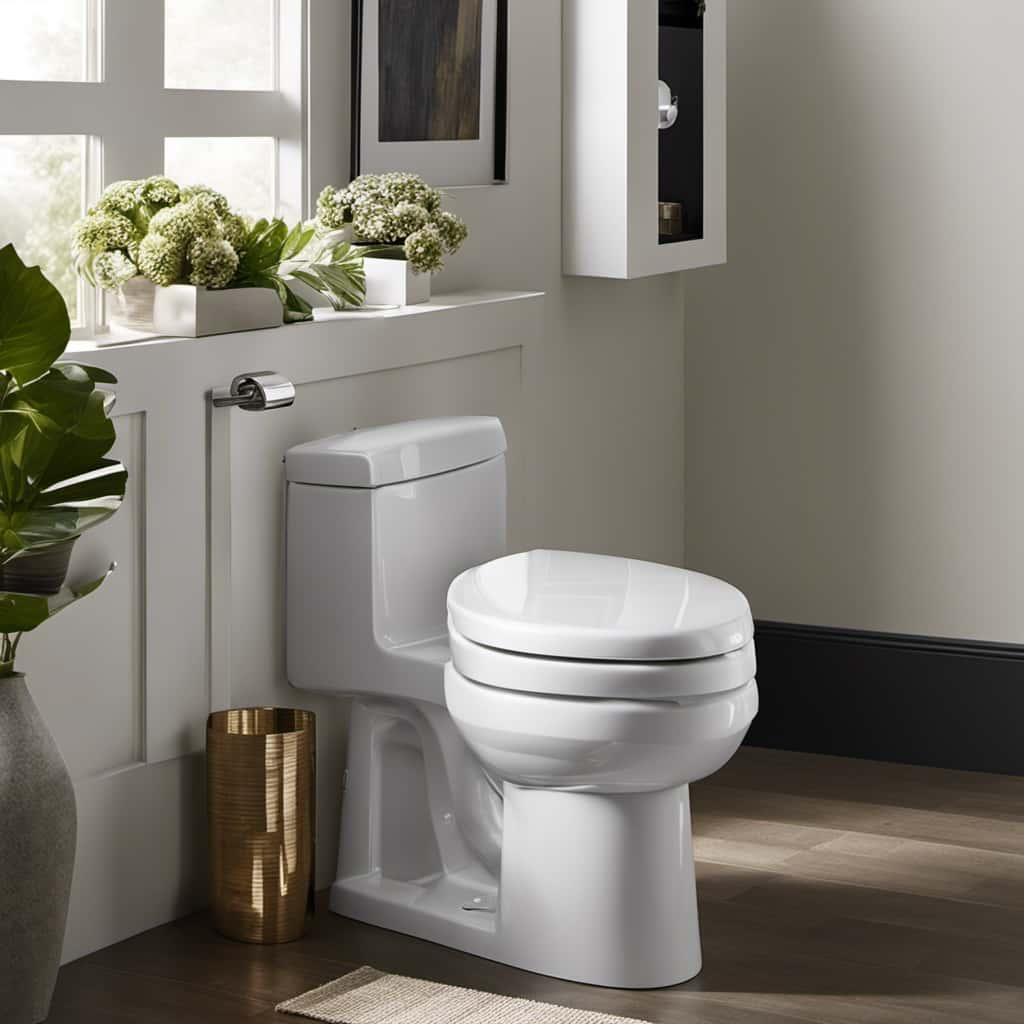
Rainwater: Eco-Friendly Flushing Solution
We can effectively utilize rainwater as an eco-friendly flushing solution. By implementing rainwater harvesting systems, we can collect and store rainwater for various purposes, including toilet flushing.
Here are three reasons why rainwater is an ideal choice for flushing:
- Sustainability: Rainwater is a renewable resource that can be collected and used repeatedly. By utilizing rainwater for flushing, we reduce the demand for freshwater sources, thereby conserving water and promoting sustainability.
- Cost-effectiveness: Implementing rainwater harvesting systems can significantly reduce water bills by providing an alternative water source for flushing. This cost-saving measure can be particularly beneficial for large households or commercial buildings with high water consumption.
- Greywater recycling: Rainwater can be combined with greywater, which is wastewater from sinks, showers, and laundry, to create a more efficient flushing solution. By recycling greywater and combining it with rainwater, we can maximize water usage and minimize water wastage.
Alternative to Plumbing
An alternative to plumbing is utilizing rainwater for flushing toilets. When it comes to alternative plumbing methods and off-grid sanitation solutions, rainwater harvesting can be an efficient and eco-friendly option.
By collecting rainwater from rooftops and storing it in tanks or cisterns, you can have a readily available water source for flushing toilets without relying on traditional plumbing systems. This method not only reduces the strain on municipal water supplies but also helps in conserving water. However, it’s important to note that rainwater harvesting for toilet flushing requires proper filtration and treatment to ensure the water is safe and free from contaminants.

Transitioning into the next section, another option to consider is installing a non-electric bidet attachment.
Install a Non-Electric Bidet Attachment
To install a non-electric bidet attachment, all we need is a simple yet effective solution. Here are three steps you can follow to install a bidet attachment without the need for electricity:
- Choose the right attachment: Look for a non-electric bidet attachment that’s compatible with your toilet. Consider factors such as water pressure control, self-cleaning nozzles, and adjustable spray patterns. These features will enhance your bidet experience and provide maximum comfort.
- Prepare the installation: Turn off the water supply to your toilet and flush it to remove any remaining water in the tank. Disconnect the water supply hose from the bottom of the tank and attach the bidet attachment to the fill valve. Ensure a secure connection and use Teflon tape for added leak protection.
- Adjust and test: Once the attachment is securely in place, adjust the water pressure to your desired level. Test the bidet by turning on the water supply and activating the spray function. Make sure there are no leaks and that the bidet is functioning properly.
Installing a non-electric bidet attachment is a straightforward process that can provide you with the many benefits of bidet hygiene without requiring electricity.
Use a Composting Toilet
Let’s continue our exploration of alternative toilet options by delving into the concept of using a composting toilet. A composting toilet is a waterless and portable composting system that converts human waste into compost through a natural decomposition process. It eliminates the need for water and sewage infrastructure, making it an eco-friendly and sustainable solution.
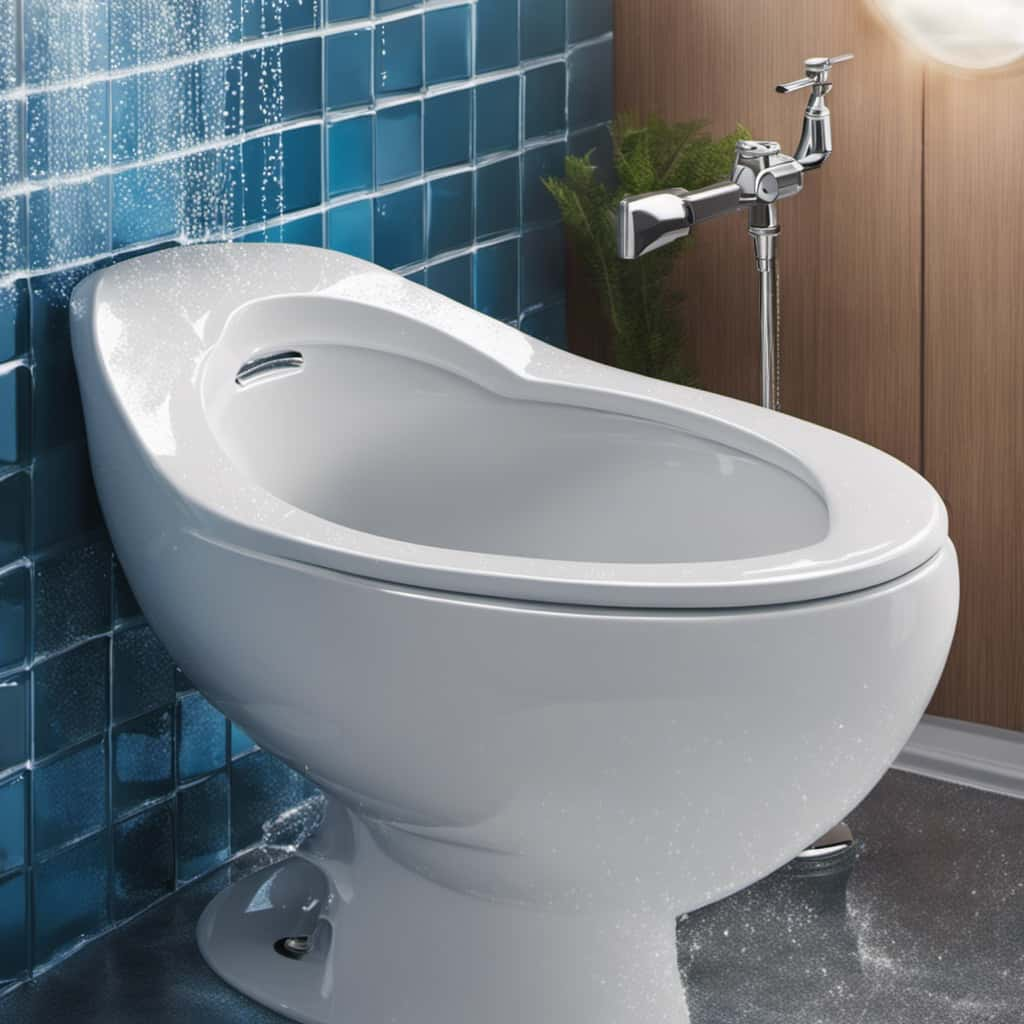
These toilets are designed with a separation system that separates liquid and solid waste. The solid waste is mixed with organic materials, such as sawdust or coconut coir, to aid in the decomposition process. The mixture is then left to decompose over time, resulting in nutrient-rich compost that can be safely used as fertilizer.
Composting toilets are a practical choice for off-grid living, camping, or areas with limited access to water and traditional sanitation systems.
Consider a Portable Camping Toilet
Let’s explore an alternative toilet option for power-free sanitation solutions: the portable camping toilet.
This portable toilet is designed for outdoor use and can be easily transported and set up in various locations. It typically consists of a seat, a waste container, and a flush mechanism that uses water or chemicals to control odor and facilitate waste disposal.

Portable camping toilets are a practical solution for situations where access to traditional flushing toilets is limited or nonexistent.
Alternative Toilet Options
One option we can consider is using a portable camping toilet as an alternative when we can’t flush the toilet due to a power outage. These toilets are designed to provide a convenient and hygienic solution in situations where traditional flushing toilets aren’t available.
Here are three reasons why portable camping toilets can be a great alternative:
- Water-saving techniques: Portable camping toilets are designed to minimize water usage. They often feature a water-saving flush mechanism or use chemicals that break down waste, reducing the need for excessive water usage.
- Eco-friendly sanitation options: Many portable camping toilets are designed to be environmentally friendly. They use biodegradable chemicals to break down waste, ensuring that it can be safely disposed of without harming the environment.
- Convenience and portability: Portable camping toilets are lightweight and easy to transport, making them a practical option for emergencies or outdoor activities. They can be set up quickly and provide a convenient and sanitary alternative when traditional flushing toilets aren’t available.
Power-Free Sanitation Solutions
As we continue our discussion on alternative toilet options, let’s explore power-free sanitation solutions, specifically the consideration of a portable camping toilet.

When faced with a power outage or lack of access to a traditional flushing toilet, a portable camping toilet can provide a practical and environmentally friendly solution for waste management. These toilets are designed to be self-contained and compact, making them convenient for use in various settings such as camping trips or emergency situations.
They typically consist of a waste storage tank, a seat, and a flushing mechanism that doesn’t require electricity. Some models even incorporate biodegradable bags or composting systems to further minimize environmental impact.
Portable camping toilets offer a power-free option for maintaining proper sanitation without compromising comfort and convenience.
Install a Manual Flush Valve
To install a manual flush valve, we need a wrench and a new valve. Here are the steps to follow:

- Turn off the water supply: Locate the shut-off valve behind the toilet and turn it clockwise to shut off the water supply. This step is crucial to avoid any water leakage during the installation process.
- Remove the old flush valve: Use the wrench to loosen the nuts connecting the old flush valve to the toilet tank. Carefully remove the old valve and discard it.
- Install the new flush valve: Take the new valve and insert it into the toilet tank, aligning it with the pre-existing holes. Secure it in place by tightening the nuts with the wrench.
Use a Septic System With Gravity Flow
We can use a septic system with gravity flow to flush the toilet without power.
A septic system is a wastewater treatment system commonly used in areas not connected to a municipal sewer system. It consists of a septic tank, where solid waste settles and is partially decomposed by bacteria, and a drainfield, where the liquid waste is released into the ground for further treatment.
Gravity flow is a key component of this system, as it allows the wastewater to flow naturally from the tank to the drainfield without the need for pumps or power. In the event of a power outage, the septic system can still function, ensuring that toilets can be flushed.
To maximize the efficiency of the septic system, rainwater harvesting and greywater recycling systems can be implemented to reduce the amount of water entering the septic tank and minimize the strain on the system.

Utilize a Chemical Toilet or Portable Potty
Let’s explore using a chemical toilet or portable potty to flush the toilet without power. These options provide a convenient and efficient solution during times of power outage or when traditional flushing methods aren’t available.
Here are three reasons why waterless composting and chemical-free portable toilets are excellent alternatives:
- Environmentally friendly: Waterless composting toilets use natural processes to break down waste into compost, reducing water usage and the need for chemical additives. This eco-friendly approach helps preserve precious water resources and eliminates the need for harmful chemicals.
- Odor control: These toilets are designed with innovative technologies to minimize odors. They often feature ventilation systems that remove unpleasant smells, ensuring a more pleasant and comfortable experience.
- Portability and versatility: Chemical-free portable toilets are lightweight and easy to transport, making them ideal for camping, RV trips, or emergency situations. They can be used in a variety of settings, providing a convenient and sanitary solution wherever you may need it.
Install a Waterless Urinal
During a power outage, our toilets can still be functional by installing a waterless urinal. Waterless urinals are alternative sanitation methods that offer a sustainable solution for water saving bathroom fixtures. These urinals work by utilizing a special cartridge that traps the urine while allowing the liquid to pass through. The cartridge contains a sealant that prevents odors from escaping and bacteria from growing. This innovative design eliminates the need for water to flush, making it an environmentally friendly option. By installing waterless urinals in our bathrooms, we can reduce water consumption and conserve this precious resource.
Transitioning to waterless urinals is a step towards a more sustainable future. However, if a waterless urinal isn’t feasible or practical, we can consider a vacuum-assisted toilet system as an alternative option.

Consider a Vacuum-Assisted Toilet System
To ensure functionality during a power outage, one option to consider is installing a vacuum-assisted toilet system. This system operates on a lower water pressure compared to traditional gravity-fed toilets, making it more efficient in conserving water.
Here are three key advantages of using a vacuum-assisted toilet system:
- Improved flushing power: The vacuum-assisted system utilizes air pressure to enhance the flushing action, resulting in a more powerful and effective flush. This ensures that waste is efficiently removed from the bowl, reducing the chances of clogs or blockages.
- Reduced maintenance requirements: Vacuum-assisted toilets are equipped with a smaller water tank, reducing the amount of water needed for each flush. This not only saves water but also reduces the frequency of tank refills and maintenance tasks such as valve replacements or flapper adjustments.
- Versatile installation options: Vacuum-assisted toilets can be installed in various locations, including basements or areas with limited water pressure. The system’s design allows for flexible installation, making it suitable for both residential and commercial settings.
Frequently Asked Questions
How Does a Gravity Flush System Work?
A gravity flush system relies on the force of gravity and water pressure to move waste through the pipes and out of the toilet. It doesn’t require power to operate, making it a reliable option.
What Are the Steps to Fill and Flush a Toilet With Water Manually?
To manually fill and flush a toilet with water, you can follow these steps: 1) Fill a bucket with water. 2) Pour the water swiftly into the toilet bowl. 3) Repeat until the desired flush is achieved.

How Can I Effectively Utilize Rainwater for Flushing the Toilet?
To effectively utilize rainwater for flushing the toilet, we can implement rainwater collection systems. These systems capture and store rainwater, which can then be used to conserve toilet water when power is unavailable.
What Are the Benefits of Installing a Non-Electric Bidet Attachment?
Installing a non-electric bidet attachment has pros and cons. It provides a hygienic and comfortable experience, but alternatives like wet wipes can be used for personal hygiene.
How Does a Composting Toilet Work and Is It Suitable for Everyday Use?
Using a composting toilet has many benefits, such as saving water and reducing waste. To maintain it, you need to regularly add sawdust or other organic matter. It’s an eco-friendly option for everyday use.
Conclusion
In conclusion, when faced with a power outage, there are several options available for flushing a toilet without electricity.

From utilizing gravity flush systems and manually filling and flushing with water, to using buckets or rainwater, there are practical solutions to maintain sanitation.
Additionally, installing non-electric bidet attachments, utilizing septic systems with gravity flow, or opting for chemical toilets or portable potties can provide alternative flushing methods.
Lastly, waterless urinals and vacuum-assisted toilet systems offer sustainable options.
So, even when the power goes out, you can still keep things flowing smoothly.






